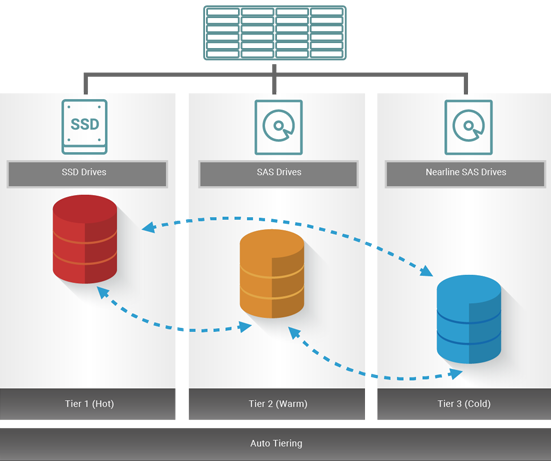Auto Tiering Storage | Tiered Storage Solutions | ACNC
Auto Tiering (QTiering) storage cost-effectively and dynamically places hot data on SSD or faster hard drives and cold data on lower-cost high-capacity drives, allowing you to optimize application performance without straining your budget or sacrificing capacity.
Download JetStor X Series Auto Tiering 2.0 White Paper >
Our QTiering algorithm uses intelligent data analysis that continuously monitors data usage and ranks this data based on how often it is accessed. It will then use this information and make a decision on where your data should be.
Our intuitive SANOS 4.0 by QSAN web UI interactively shows the data being gathered; how this data is being used, and how much of each tier storage should be assigned based on this information. Then at the scheduled time, the most accessed blocks that have been marked as “hot” data will be migrated into the highest performing tier, and the least accessed or “cold” data will be migrated into the lowest cost – highest capacity drive tier for the most efficient data tiering.

3 Levels of Tiered Storage Solutions
QTiering supports 3 tiers of different drive types.
• Tier 1: SAS/SATA* 2.5” SSD drive
• Tier 2: 15K/10K 3.5”/2.5” SAS drive
• Tier 3: 7.2K near-line 3.5”/2.5” SAS drive

Intelligent QTiering Mechanism
QTiering manages the data relocation and monitors the data hotness ratio using the half-life coefficient and advanced ranking mathematics. There are three major functions in Qtiering data tiering.
• Sub-LUN Statistics: The volume is divided into 1GB units, which is called a sub-LUN. This is the basic unit of data movement among tiers. Whenever there are I/O requests, the activity level of a sub-LUN is determined by counting the read and write frequency of the sub-LUN.
• Ranking Algorithm: Access records of each sub-LUN are collected and analyzed every hour. LVM maintains a cumulative I/O count and weighs each I/O by how recently it arrived, using a half-life coefficient. The ranking algorithm then uses these statistics to calculate the percentage of hot data.
• Data Movement: The data relocation engine then uses these percentages as guidance to move sub-LUNs between storage tiers automatically. The data relocation process will neither interfere with I/O nor stop I/O services. When data relocation begins to move sub-LUNs from the slower tier to the faster tier, you will notice the I/O performance increases over time.

